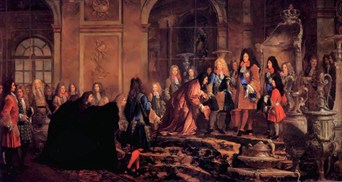Court
 The term “court” means the residence of the sovereign and, by extension, his family and their staff, the courtiers, or those persons who hold, often indistinctly, domestic and government offices. The best known case is that of the itinerant court of Charles V (1500-1558), who loved to travel in his dominions, creating an itinerant, cosmopolitan and polyglot court. In the Early Modern period the court took on its characteristics with respect to the past, formalizing its admission requirements, the functions of its members and its ceremonial rules. The old domestic functions were transformed into a system of charges and dignities of government. The centre of political life, it represented an institutional and symbolic space, shrouded by an atmosphere of sacredness and reverence, a metaphor of the rigid hierarchy of the ancien régime. A fundamental step in order to reach such a configuration is represented by the spread of so-called “Burgundian ceremonials”: a special and successful version of court, introduced in the mid sixteenth century, in particular in Spain but which later spread to most European courts. According to its provisions, the nobles who resided at the court had the privilege to perform domestic duties at the service of the king, helped him wash and dress, accompanied him in riding and hunting, attending to his meals etc. Everything following a ritual and gestures designed to enhance the sacredness of the body of the sovereign.
The term “court” means the residence of the sovereign and, by extension, his family and their staff, the courtiers, or those persons who hold, often indistinctly, domestic and government offices. The best known case is that of the itinerant court of Charles V (1500-1558), who loved to travel in his dominions, creating an itinerant, cosmopolitan and polyglot court. In the Early Modern period the court took on its characteristics with respect to the past, formalizing its admission requirements, the functions of its members and its ceremonial rules. The old domestic functions were transformed into a system of charges and dignities of government. The centre of political life, it represented an institutional and symbolic space, shrouded by an atmosphere of sacredness and reverence, a metaphor of the rigid hierarchy of the ancien régime. A fundamental step in order to reach such a configuration is represented by the spread of so-called “Burgundian ceremonials”: a special and successful version of court, introduced in the mid sixteenth century, in particular in Spain but which later spread to most European courts. According to its provisions, the nobles who resided at the court had the privilege to perform domestic duties at the service of the king, helped him wash and dress, accompanied him in riding and hunting, attending to his meals etc. Everything following a ritual and gestures designed to enhance the sacredness of the body of the sovereign.
